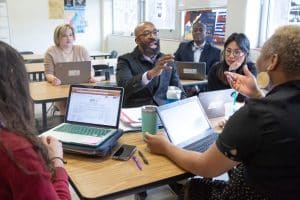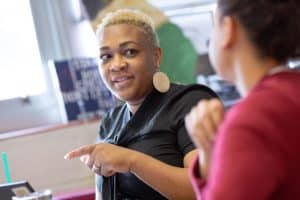Dangerous Conversations: The Importance of Empathy, Grace, and Skill
CompetencyWorks Blog
Remember a time out in the world when you felt in danger, maybe you narrowly avoided a traffic disaster. What does it feel like when that happens? You break out in a sweat. You’re nauseated. Your hands might shake. Your mouth goes dry. You get short tempered with other people in the car. You might need to find a bathroom quickly. In a phenomenological sense, how do you know when you’re in danger? When you feel those things; when you get a pit in your stomach.
We talk about brave spaces and courageous, crucial, and essential conversations, but we often sidestep why they need bravery or courage. We sidestep that educators might feel these conversations are dangerous. They might feel in danger. Educators talking about change in schools might feel that pit in their stomach when they enter these conversations.
Every conversation has emotional content, and that content lives within each participant.
So, what are we afraid of? That is a powerful and rich question. Michael Fullan tells us the following:
People don’t fear change; they fear loss.
This is a vital reframing. In our society—which can get caught up in innovation for innovation’s sake, efficiency, and test scores—it is easy to dismiss someone for “fearing change,” especially when you wish they’d just get out of your way.
But to “fear loss”? That’s something we all do. That is as close to a universal human experience as I can imagine. When you encounter the fear of loss rather than the fear of change, empathy is much more available to you and everyone in the room. You’re already having a profoundly more interesting conversation.
Okay. What are we afraid of losing?

Every group is different. I’ve asked this question of hundreds of educators. The answers are always intensely local and contextual. I recommend having this conversation with every group you’re trying to coach through change. Having said that, here are some of the things folks on both sides of an argument fear losing:
- Professional esteem – they will be thought less of by their peers.
- Their own sense of competence – they will be learning a new thing and might not be as good at it.
- Their sense of their own goodness – are you a good person if you’ve been doing bad pedagogy in the past? (Yes! You are. But some people worry. No one wants to think that their past practice has hurt kids.)
- Collegiality and civility – you can dismiss it as folks being conflict averse, but fear of anger is a real thing, and it ought to be a real thing. Angry people can be scary and unpredictable.
- Peace in the community – especially in these polarizing times, especially around issues of equity and justice.
- Professional stability – consequences from one’s response to initiatives can be reflected in reviews, discipline, renewal, etc.
Notice how many of these things are personal, non-policy-related sources of anxiety. Powerful emotional responses to change are not typically because of the technical specifics of the change being proposed or opposed. Conversations around equity and ethical practices center on differences in values. Changing an assessment system is about prioritizing different values. Discussing what we value as humans is a very vulnerable thing, almost intimate.
Working with these ideas at Educating for Good, the most powerful tool we’ve discovered to navigate dangerous conversations is to recognize them as such. It’s an unfamiliar framing for teachers, and those we’ve worked with in our consulting practice appreciate it. Calling them dangerous conversations—because that is often how teachers experience them—affirms the teacher’s experience. As if to say, “It’s not because you’re too sensitive, or need to grow a thicker skin, or need to be educated, or need to be willing to change, or need to trust your colleagues—it’s because this conversation comes with high stakes and vulnerability and being wary is an appropriate response.”

The most powerful tool we’ve discovered to address that wariness is to get training in how to have high-stakes conversations with a high level of emotional content. It’s a skill that can be learned! The use of protocols can have almost miraculous results. Bringing in a skilled facilitator can also be fantastic, not only because they are … well … skilled, but because they are an outsider who hasn’t planted a flag, and won’t.
As important as all of that is, it’s necessary to have a culture that is skilled in these kinds of conversations. This takes time and attention to relationships. It requires not only a change in how you have conversations, but why. The faculty have to trust the leadership, and the leadership have to be trustworthy. The leadership has to trust the faculty and students, set aside the illusion of control, and learn to embrace what comes out of the conversations, not just use the conversations to marshal agreement.
It’s important to note that this sense of danger is not a new phenomenon. In the areas of racial justice, DEI, or LGBTQ issues, for example, conversations of this sort have always felt dangerous, for good reason.
The need for the rest of us to have these dangerous conversations is not evidence that something is going wrong in your school. The stereotype of a well-run classroom is that it’s quiet. The same is thought to be true of a school building. But that’s not what we’re looking for when we go into a learner-centered environment. Humans do things that feel dangerous all the time which are good and necessary. They are things that humans must go through (not over, under, or around), and the amount of empathy and grace—and skill—we have while doing so will determine how we feel at the end and what comes out of it.
Learn More
- How Many Conversations?
- 10 Questions for Educators to Reflect on Their Expectations for Students
- Making the Shift: Why Is It So Hard to Scale Equitable, Learner-Centered Education?
 Gary Chapin is the co-author of 126 Falsehoods We Believe About Education (2021). He has been working in education since 2000, first as a teacher, then as a curriculum director, then as a Dept. of Ed. researcher, and most recently as an advocate and supporter of equity-based practices such as competency-based learning, performance assessment, adaptive leadership, and collaborative cultures. Currently working with Educating for Good, he is deeply fascinated by questions like: What should kids learn? How do we decide what kids should learn? Who decides? How do we learn what they learned? How can learning what they learned help them learn more? Also: systems!
Gary Chapin is the co-author of 126 Falsehoods We Believe About Education (2021). He has been working in education since 2000, first as a teacher, then as a curriculum director, then as a Dept. of Ed. researcher, and most recently as an advocate and supporter of equity-based practices such as competency-based learning, performance assessment, adaptive leadership, and collaborative cultures. Currently working with Educating for Good, he is deeply fascinated by questions like: What should kids learn? How do we decide what kids should learn? Who decides? How do we learn what they learned? How can learning what they learned help them learn more? Also: systems!